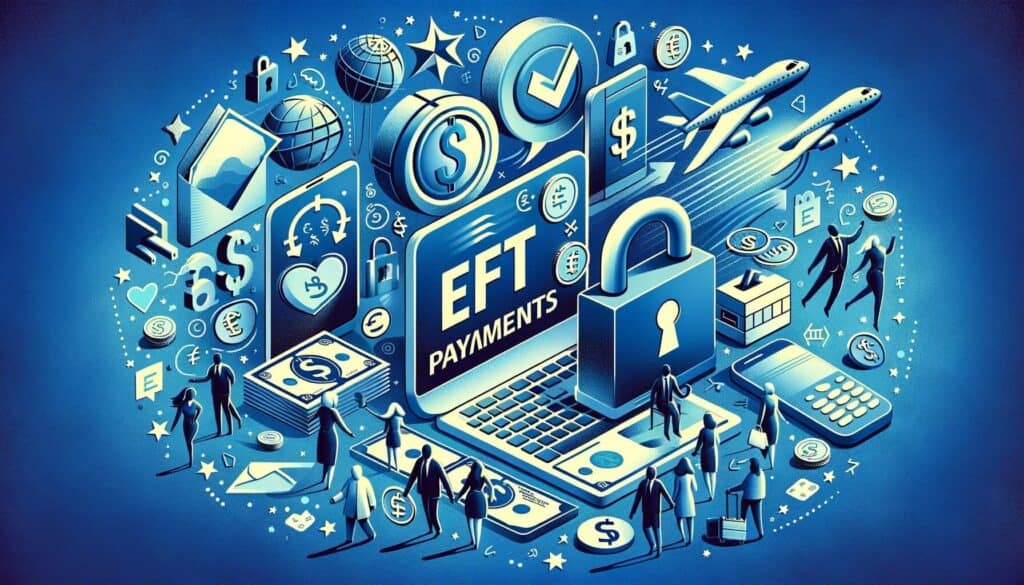
By Carol Peters March 30, 2025
Electronic Funds Transfer (EFT) payments have become increasingly popular in today’s digital age. This method of payment allows individuals and businesses to transfer funds electronically, eliminating the need for physical checks or cash. EFT payments offer convenience, speed, and security, making them a preferred choice for many transactions.
In this article, we will delve into the world of EFT payments, exploring how they work, their benefits, different types, setting up processes, security measures, choosing the right service provider, common challenges, and frequently asked questions.
How EFT Payments Work: A Step-by-Step Guide

EFT payments involve the electronic transfer of funds from one bank account to another. The process typically begins with the payer initiating the payment through their chosen payment method, such as online banking, mobile banking apps, or payment gateways. The payer provides the necessary information, including the recipient’s account number, bank routing number, and the amount to be transferred.
Once the payment is initiated, the payer’s financial institution verifies the availability of funds in the payer’s account. If the funds are available, the financial institution sends an electronic message to the recipient’s bank, requesting the transfer of funds. The recipient’s bank then verifies the account details and ensures that the funds are credited to the correct account.
The recipient’s bank processes the payment and updates the recipient’s account balance accordingly. The payer’s financial institution deducts the transferred amount from the payer’s account. The entire process usually takes a few seconds to a few business days, depending on various factors such as the banks involved, the payment method used, and any intermediary processes.
Benefits of EFT Payments: Why Businesses and Individuals Choose This Method

EFT payments offer numerous benefits for both businesses and individuals. One of the key advantages is the convenience it provides. With EFT payments, there is no need to write checks, handle cash, or visit physical bank branches. Payments can be made from the comfort of one’s home or office, using a computer or mobile device. This convenience saves time and effort, allowing individuals and businesses to focus on other important tasks.
Another significant benefit of EFT payments is the speed of transactions. Unlike traditional payment methods, such as checks, which can take several days to clear, EFT payments are typically processed within seconds or a few business days. This quick turnaround time ensures that funds are transferred promptly, enabling businesses to meet their financial obligations and individuals to access their funds without delay.
EFT payments also offer enhanced security compared to physical payment methods. With checks or cash, there is always a risk of loss, theft, or fraud. EFT payments, on the other hand, are encrypted and transmitted securely, reducing the chances of unauthorized access or interception. Additionally, electronic records of transactions provide a clear audit trail, making it easier to track and resolve any discrepancies.
Furthermore, EFT payments are cost-effective for both businesses and individuals. Traditional payment methods often incur fees, such as check printing or processing fees. EFT payments, however, usually have lower or no transaction fees, resulting in cost savings over time. Businesses can also benefit from reduced administrative costs associated with manual payment processing and reconciliation.
Different Types of EFT Payments: Exploring the Options

There are several types of EFT payments available, each catering to different needs and preferences. The most common types include Automated Clearing House (ACH) transfers, wire transfers, and electronic wallets.
ACH transfers are widely used for various types of transactions, such as direct deposits, bill payments, and business-to-business payments. ACH transfers are typically processed in batches, allowing for efficient and cost-effective transfers. They are commonly used for recurring payments, such as monthly utility bills or employee salaries.
Wire transfers, on the other hand, are used for urgent or high-value transactions that require immediate transfer of funds. Wire transfers are often used for international payments, real estate transactions, or large business transactions. While wire transfers offer speed and security, they usually come with higher fees compared to other types of EFT payments.
Electronic wallets, such as PayPal, Venmo, or Apple Pay, have gained popularity in recent years. These wallets allow individuals to store their payment information securely and make quick and easy transactions online or through mobile devices. Electronic wallets often offer additional features, such as peer-to-peer payments, splitting bills, or loyalty programs, making them a convenient choice for everyday transactions.
Setting Up EFT Payments: A Comprehensive Guide for Businesses and Individuals
Setting up EFT payments requires a few essential steps to ensure smooth and secure transactions. For businesses, the first step is to determine the payment methods they want to offer to their customers. This may include ACH transfers, credit card payments, or electronic wallets. Businesses should consider the preferences of their target audience and the compatibility of payment methods with their existing systems.
Once the payment methods are selected, businesses need to establish relationships with payment processors or financial institutions that can facilitate the EFT payments. It is crucial to choose a reliable and reputable service provider that offers secure and efficient payment processing services. Businesses should consider factors such as transaction fees, customer support, integration options, and security measures when selecting a payment processor.
For individuals, setting up EFT payments typically involves linking their bank accounts to their chosen payment method. This can be done through online banking platforms or mobile banking apps. Individuals need to provide their account details, such as account number and routing number, to authorize the transfer of funds. Some payment methods may also require additional verification steps, such as confirming small deposits or providing identification documents.
Security Measures in EFT Payments: Ensuring Safe and Secure Transactions
Security is a critical aspect of EFT payments, as it involves the transfer of sensitive financial information. To ensure safe and secure transactions, various security measures are implemented by financial institutions, payment processors, and individuals.
Encryption is one of the primary security measures used in EFT payments. Encryption involves encoding the data transmitted during the payment process, making it unreadable to unauthorized parties. Advanced encryption algorithms, such as Secure Sockets Layer (SSL) or Transport Layer Security (TLS), are commonly used to protect the confidentiality and integrity of the data.
Authentication is another crucial security measure in EFT payments. Authentication verifies the identity of the parties involved in the transaction, ensuring that only authorized individuals or entities can initiate or receive payments. This can be achieved through various methods, such as passwords, PINs, biometric authentication, or two-factor authentication (2FA).
Financial institutions and payment processors also implement robust security protocols and monitoring systems to detect and prevent fraudulent activities. These measures may include real-time transaction monitoring, anomaly detection algorithms, and anti-fraud tools. Additionally, regular security audits and compliance with industry standards, such as Payment Card Industry Data Security Standard (PCI DSS), are essential to maintain the security of EFT payments.
Individuals can also take steps to enhance the security of their EFT payments. This includes using strong and unique passwords for their online banking or payment accounts, regularly updating their devices and software, and being cautious of phishing attempts or suspicious emails. It is also advisable to monitor account activity regularly and report any unauthorized transactions immediately to the financial institution.
EFT Payment Processors: Choosing the Right Service Provider
Choosing the right EFT payment processor is crucial for businesses and individuals to ensure smooth and secure payment processing. There are several factors to consider when selecting a service provider.
Firstly, businesses and individuals should evaluate the compatibility of the payment processor with their existing systems or platforms. Integration options, such as APIs or plugins, can simplify the payment process and provide a seamless user experience. It is essential to choose a payment processor that offers easy integration and supports the required payment methods.
Transaction fees are another important consideration. Different payment processors may have varying fee structures, including flat fees, percentage-based fees, or a combination of both. Businesses should assess their transaction volume and average transaction value to determine the most cost-effective option. It is also advisable to consider any additional fees, such as setup fees, monthly fees, or chargeback fees, when comparing payment processors.
Security measures implemented by the payment processor should be thoroughly evaluated. This includes encryption protocols, authentication methods, fraud detection systems, and compliance with industry standards. Businesses and individuals should ensure that the payment processor follows best practices to protect sensitive financial information and prevent unauthorized access.
Customer support is another crucial aspect to consider. Prompt and reliable customer support can help resolve any issues or concerns related to payment processing quickly. It is advisable to choose a payment processor that offers multiple support channels, such as phone, email, or live chat, and has a reputation for excellent customer service.
Reputation and reliability of the payment processor should also be taken into account. Researching customer reviews, testimonials, and industry rankings can provide insights into the service quality and reliability of the payment processor. It is advisable to choose a reputable and established payment processor with a track record of secure and efficient payment processing.
Common Challenges and Solutions in EFT Payments: Troubleshooting Guide
While EFT payments offer numerous benefits, there can be challenges that individuals and businesses may encounter. Understanding these challenges and their solutions can help troubleshoot any issues that may arise.
One common challenge is transaction failures or delays. This can occur due to various reasons, such as technical issues, insufficient funds, incorrect account details, or network connectivity problems. In such cases, individuals should verify their account balance, ensure the accuracy of the recipient’s account details, and check for any error messages or notifications from their financial institution. If the issue persists, contacting the financial institution or payment processor’s customer support can help resolve the problem.
Another challenge is the risk of fraud or unauthorized transactions. Despite the security measures in place, there is always a possibility of fraudulent activities. Individuals and businesses should regularly monitor their account activity, review transaction details, and report any suspicious or unauthorized transactions immediately to their financial institution. It is also advisable to enable transaction alerts or notifications to stay informed about any unusual activity.
Technical issues or system downtime can also pose challenges in EFT payments. This can disrupt the payment process and cause inconvenience for individuals or businesses. In such cases, individuals should ensure that their devices and software are up to date, clear cache and cookies, and try accessing the payment platform from a different device or browser. If the issue persists, contacting the payment processor’s customer support can help resolve the technical problem.
Frequently Asked Questions (FAQs) about EFT Payments: Clearing the Doubts
Q1. What is the difference between ACH transfers and wire transfers?
Answer: ACH transfers are typically used for non-urgent, low-value transactions, while wire transfers are used for urgent or high-value transactions. ACH transfers are processed in batches and usually take a few business days to clear, while wire transfers are processed individually and can be completed within hours or minutes.
Q2. Are EFT payments secure?
Answer: Yes, EFT payments are generally secure. They utilize encryption, authentication, and other security measures to protect sensitive financial information. However, individuals and businesses should also take precautions, such as using strong passwords and monitoring account activity, to enhance security.
Q3. Can EFT payments be reversed?
Answer: EFT payments can be reversed in certain circumstances, such as unauthorized transactions or errors. However, the process and requirements for reversals may vary depending on the financial institution or payment processor. It is advisable to contact the relevant institution or processor for specific instructions.
Q4. Can EFT payments be made internationally?
Answer: Yes, EFT payments can be made internationally through wire transfers or electronic wallets. However, international EFT payments may involve additional fees, longer processing times, and compliance with international regulations.
Q5. Can EFT payments be used for recurring payments?
Answer: Yes, EFT payments, particularly ACH transfers, are commonly used for recurring payments, such as monthly bills or employee salaries. Setting up automatic payments can simplify the payment process and ensure timely payments.
Conclusion
EFT payments have revolutionized the way individuals and businesses transfer funds electronically. With their convenience, speed, and security, EFT payments have become a preferred method for various transactions.
Understanding the basics of EFT payments, how they work, their benefits, different types, setting up processes, security measures, choosing the right service provider, common challenges, and frequently asked questions is essential for anyone involved in electronic payment transactions.
By embracing EFT payments and following best practices, individuals and businesses can enjoy the advantages of seamless and secure financial transactions in the digital era.
